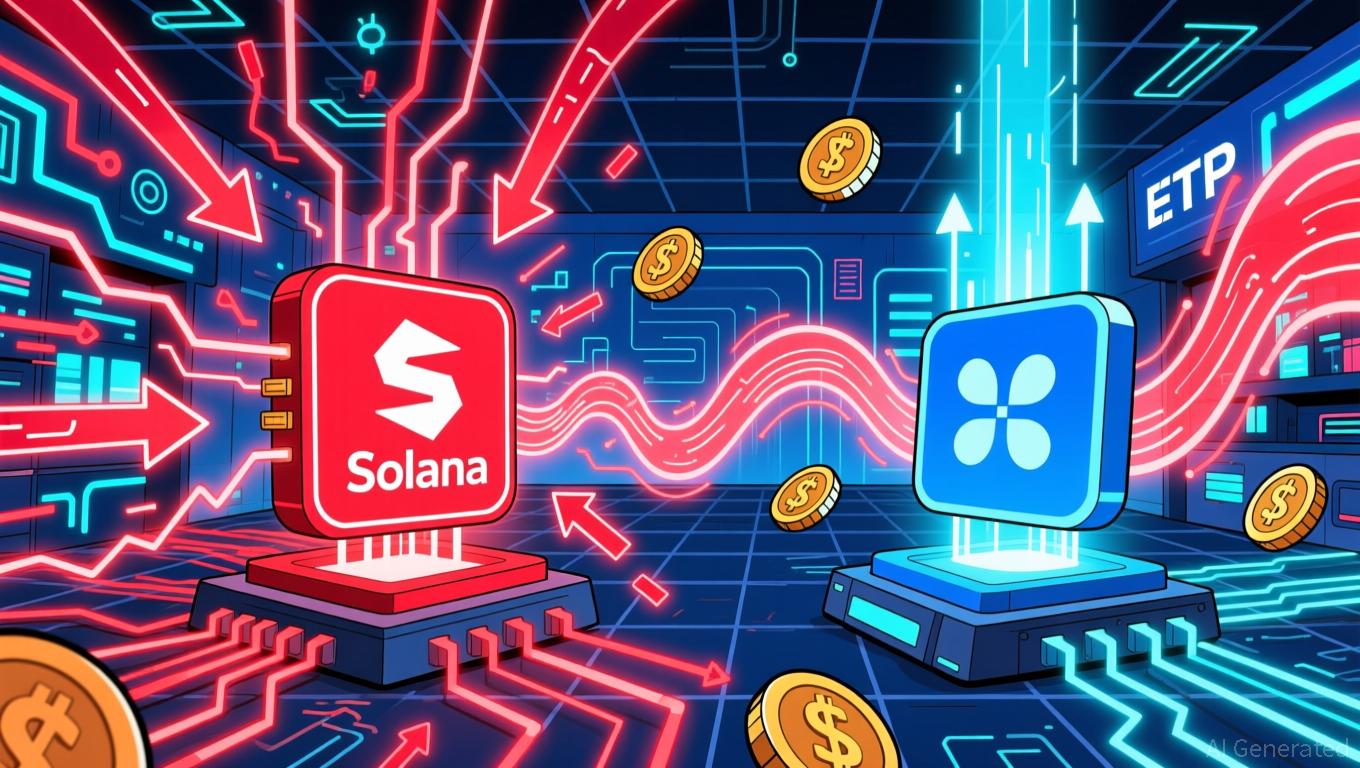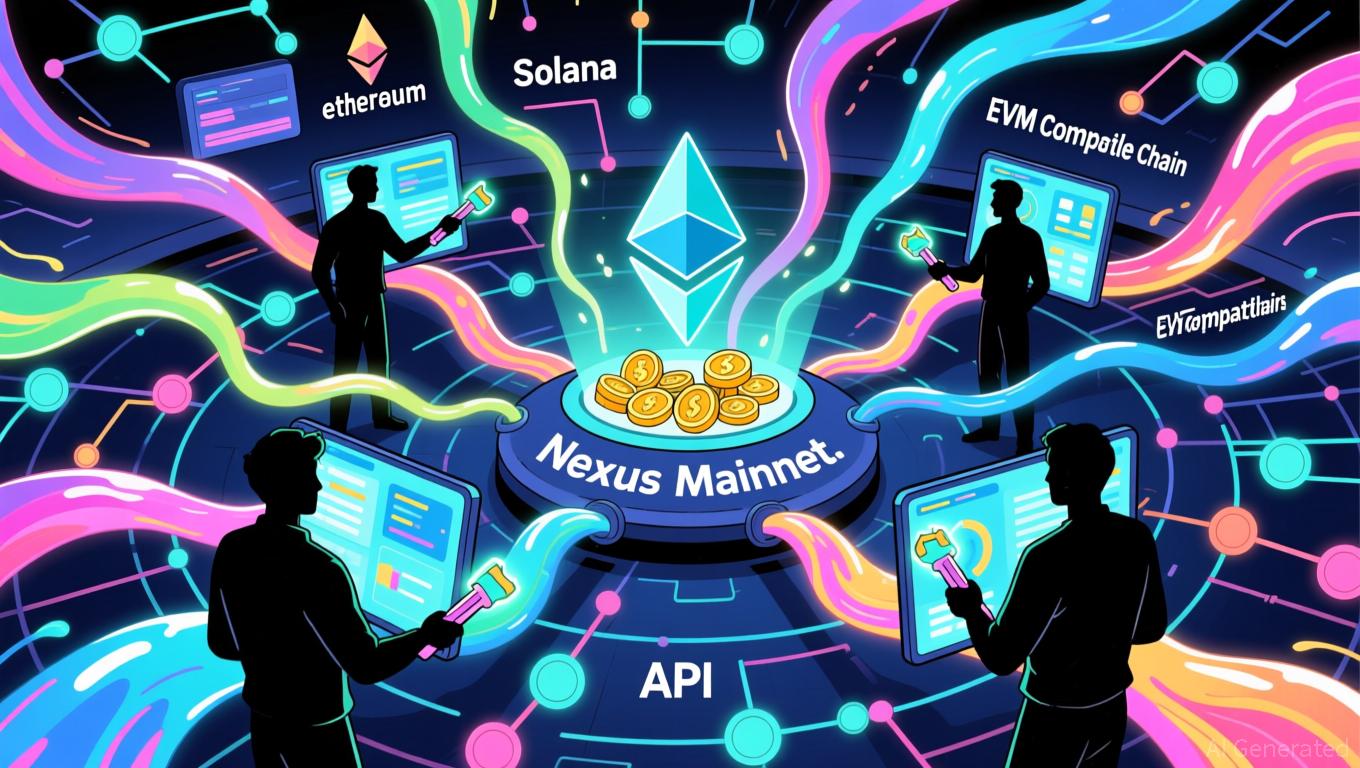PENGU Token's Latest Rally: An In-Depth Look at Technical Trends and Market Sentiment
- PENGU token's November 2025 volatility stems from mixed on-chain flows, institutional interest, and macroeconomic factors. - Cboe's pending PENGU/NFT ETF filing could trigger institutional inflows or sharp sell-offs depending on SEC approval. - Technical indicators show conflicting signals: bullish OBV/MACD vs. overbought RSI and critical $0.012 support level. - FTX-related regulatory pressures and NFT market contraction (36% sales drop) pose structural bearish risks. - Traders face high-risk/reward dyna
PENGU Token: November 2025 Market Overview
The PENGU token, which is integral to the Pudgy Penguins NFT ecosystem, has shown significant price swings throughout November 2025. These fluctuations have been shaped by a combination of blockchain activity, institutional engagement, and broader economic factors. This report explores the token’s short- and medium-term trading prospects, emphasizing technical signals, capital movement, and key price levels relevant for active market participants.
Blockchain Trends and Capital Flows
Recent blockchain analytics highlight a nuanced mix of optimistic and pessimistic signals. Experienced traders have contributed $157,000 to PENGU, while large holders have accumulated $273,000, indicating deliberate efforts to support the price. However, these positive inflows have been partially counterbalanced by $66.6 million exiting team-controlled wallets, raising concerns about potential sell-offs or profit-taking. Trading volume for the PENGU/USDT pair has jumped by 33%, reflecting increased activity from both retail and institutional investors and signaling robust liquidity.
A pivotal development is the Cboe’s application for a PENGU/NFT ETF, currently under SEC review. Approval could pave the way for significant institutional investment, similar to the surge seen in Bitcoin after its ETF launch. On the other hand, a rejection could prompt a swift decline, as observed in previous regulatory decisions. Meanwhile, Pudgy Penguins’ NFT sales have dropped by 36% in just one week, falling to $2.8 million, which points to declining speculative interest and introduces a bearish risk factor.
Technical Analysis and Price Structure

From a technical perspective, PENGU presents a mixed outlook. The On-Balance Volume (OBV) has stayed positive since early November, indicating ongoing accumulation by informed traders. The MACD indicator has also turned bullish, supporting upward momentum. However, the Relative Strength Index (RSI) has reached overbought territory, suggesting a possible short-term pullback.
Price movements reveal a five-wave pattern on the hourly chart, with the fourth wave correcting toward the $0.01050–$0.01060 range—a healthy retracement rather than a reversal. The token is currently priced at $0.01103, having recovered the $0.0106–$0.0110 band after a brief dip. The $0.012 level serves as key resistance; a breakdown here could lead to cascading liquidations and a retest of the $0.004 area. Conversely, a breakout above $0.0235, following a wedge formation, could set sights on $0.026.
Impact of FTX and Market Sentiment
The aftermath of FTX’s collapse continues to weigh on PENGU’s market behavior. New regulations, such as the U.S. GENIUS Act and the EU’s MiCA, have increased compliance costs and restricted liquidity for speculative assets. Additionally, the DeFi exploit involving Balancer on November 3, 2025, heightened market instability, causing ripple effects across interconnected protocols and accelerating PENGU’s decline as investors exited positions amid uncertainty.
FTX’s ongoing creditor repayment plan has also influenced the market. In late 2025, the exchange distributed $1.6 billion to creditors, with smaller accounts receiving up to 120% of their deposits. This redistribution of funds has indirectly affected PENGU by shifting overall market liquidity. Meanwhile, Pudgy Penguins’ collaborations with Bearbrick and Kung Fu Panda are designed to enhance brand visibility and attract retail investors, offering potential for long-term growth.
Risk and Reward Considerations for Traders
For those actively trading PENGU, the token offers both significant risks and potential rewards. The bullish scenario depends on several factors:
- Maintaining Support at $0.012: If this level holds, PENGU could advance toward $0.0235 and higher.
- ETF Approval: A positive decision on the Cboe ETF could trigger institutional buying, echoing Bitcoin’s rally in 2024.
- Utility-Driven Demand: The Pudgy Party mobile game has attracted $9.4 million in strategic investments, and continued whale accumulation suggests ongoing interest.
However, traders should be aware of the following risks:
- Regulatory Setbacks: A rejected ETF application could result in sharp declines.
- Structural Weakness: Falling below $0.012 may lead to a retest of the $0.004 level.
- NFT Market Downturn: The recent 36% drop in NFT sales signals reduced speculative appetite, adding to bearish pressures.
Summary
PENGU’s recent performance reflects a tug-of-war between bullish accumulation and underlying bearish risks. While technical indicators like OBV and MACD point to short-term strength, overbought RSI levels and regulatory uncertainties warrant caution. Traders should keep a close watch on the $0.012 support and $0.0235 resistance, as well as the outcome of the Cboe ETF application. For those willing to take on risk, a breakout above $0.0235 could justify a bullish outlook in the medium term, but prudent stop-loss strategies below $0.01050 are recommended to limit potential losses.
Disclaimer: The content of this article solely reflects the author's opinion and does not represent the platform in any capacity. This article is not intended to serve as a reference for making investment decisions.
You may also like
Ethereum News Update: Amundi’s Integrated Approach Connects Blockchain with Conventional Financial Regulations
- Amundi, Europe's largest asset manager, launched its first Ethereum-based tokenized money-market fund, enabling 24/7 settlements and transparent record-keeping via blockchain. - The hybrid model, developed with CACEIS, combines traditional fund operations with blockchain-based ownership, preserving regulatory compliance while expanding investor access. - Ethereum's dominance in stablecoin and RWA transfers ($105.94B in 30 days) underscores its role in accelerating tokenization, with Amundi positioning it

XRP News Today: XRP ETFs Drive Price Increases, While Solana ETFs Ease Selling Pressure
- XRP ETFs raised $587M in inflows since late November, outpacing Solana's $568M as investors favor altcoins with regulatory clarity and utility. - Bitwise XRP ETF's $107M debut and zero-fee strategy drove momentum, while Solana ETFs faced $156M weekly outflows due to network reliability concerns. - XRP's inflows acted as a "battering ram" pushing prices above $2.27, contrasting Solana's ETFs which merely dampened sell pressure without reversing its decline. - Analysts predict XRP could reach $3 by Decembe

The Federal Reserve's Change in Policy and Its Impact on Alternative Cryptocurrencies Such as Solana
- Fed's 2025 policy shifts, including rate cuts and stablecoin regulations, are reshaping altcoin markets by altering liquidity and risk appetite. - Solana's Alpenglow upgrade (150ms finality, 1M TPS) addresses scalability issues, aligning with Fed's AI-driven infrastructure focus despite network reliability concerns. - Institutional inflows into Solana ETFs ($100M AUM) contrast with retail caution (78% HODLers in red), highlighting divergent risk perceptions amid 30% price corrections. - Divergent ETF flo

Avail's Intent-Driven Nexus Addresses the Issue of Fragmented Liquidity Across Chains
- Avail launches Nexus Mainnet, a cross-chain solution unifying liquidity across Ethereum , Solana , and EVM networks. - The intent-solver model enables seamless asset transfers without technical complexities, streamlining user experiences. - Developers gain modular tools for multichain integration, reducing costs as cross-chain liquidity demand grows. - Nexus abstracts execution layers, offering unified balances and execution while addressing fragmentation challenges. - With $50B+ in cross-chain activity
